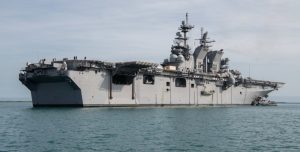The Senate Armed Services Committee (SASC) version of the FY ‘22 defense policy bill would extend authority for the Navy to buy several amphibious vessels at once, but also asks the service to provide reports on the merits for the decision and upgrade potential.
Last year, the FY ‘21 defense authorization act included a provision
allowing the Navy to procure three San Antonio-class LPD-17 amphibious transport dock ships–LPD-32, LPD-33 and LPD-34–and one America-class amphibious assault ship, LHA-10, at once (Defense Daily, June 11, 2020).
However, by June of this year the top Navy acquisition official said it was unlikely the Defense Department would go forward with the procurement this year.
In June, Acting Assistant Secretary of the Navy for Research, Development, and Acquisition Jay Stefany told a SASC panel that the service reached a “handshake agreement” with shipbuilder Huntington Ingalls Industries [HII] on what the deal would look like. However, Stefany also said it looked like the Pentagon wanted to defer the decision as it worked on the FY ‘23 budget request cycle, while deciding on the new overall force structure (Defense Daily, June 9).
In its draft of the FY ‘22 defense authorization act, a Senate report reiterated that “the committee believes that a block buy, multi-ship, or multiyear procurement approach for LPD-17 Flight II-class amphibious transport ships and LHA-10 would provide substantial cost savings as well as needed stability and predictability for the shipbuilder and its vendor base.”
The bill language extends the previous allowance into FY ‘22, called Section 124 authority.

This matches the House version of the bill, which also approved an amendment extending the amphibious multi-ship procurement authority one more year (Defense Daily, July 28).
The report noted the Navy previously estimated this block buy would save eight to 12 percent, or about $1 billion, versus four separately procurement contracts.
However, the committee included language directing the Secretary of the Navy to also submit a report to the congressional defense committees by October 2021 “on the merits of pursuing a block buy, multi-ship, or multiyear procurement acquisition strategy for LPD-17 Flight II-class ships and LHA-10.”
The report would include a business case analysis comparing the cost and schedule of single ship contracts versus multiple ship contracts in numerous groupings. This includes groups of LPD-32 and -33 and LHA-10; all four ships, and “any other groupings identified by the Secretary.”
The report may also include a description of other key considerations the Navy Secretary “deems appropriate.”
If the business case analysis shows that pursuing a block buy, multi-ship, or multiyear procurement strategy for LPD-17 Flight II-class ships and LHA-10 has merit, “the committee strongly encourages the Secretary to include such a proposal in the Navy’s budget request for fiscal year 2023,” the report added.
The SASC bill report also directs the Navy Secretary to submit a report to the defense committee on provisions to upgrade the current and future San Antonio-class ships due by Feb. 1, 2022.
“The committee understands the Navy and Marine Corps are reviewing lethality and survivability upgrades for San Antonio-class amphibious ships to support Expeditionary Advanced Base Operations and Distributed Maritime Operations,” the report said.
This second report should, at minimum, evaluate the cost, schedule and operational benefits of upgrading the ship’s Raytheon Technologies [RTX] SPY-6(V)2 Enterprise Air Surveillance Radar (EASR) rotating radar to the company’s newer SPY-6(V)3 fixed-face EASR; integrating at least a 16-cell Mark-41 Vertical Launch System (VLS); and integrating the EASR and Mark-41 VLS options with versions of the Tomahawk Weapon Control System, Ship Self-Defense System, and Cooperative Engagement Capability (CEC) and the Aegis Combat System.
SASC said the EASR radar upgrade is aimed at improving air traffic control, air and missile defense-in-depth for forces operating at sea, air and missile defense for forces operating ashore within radar range; and other offensive and defensive engagements.
“Based on the courses of action evaluated, the Secretary shall identify the optimal approach in terms of cost, schedule, and operational benefits for upgrading the sensors, weapons, and combat system on current and future San Antonio-class ships,” the report said.
The new Flight II San Antonio-class ships being built were chosen as the winner of a previous LX(R) replacement program for the next type of amphibious transport dock ships to replace the 12 aging Whidbey Island/Harpers Ferry-class (LCD-41/49) amphibious ships.
Flight II ships are billed as able to support the new Textron [TXT] Ship-to-Shore Connector, CH-53K helicopter and MV-22 Osprey as well as improved armory and weapons stowage. The Navy and Marine Corps uses these kinds of ships to embark and land Marines.